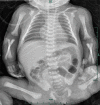Hepatic portal venous gas without definite clinical manifestations of necrotizing enterocolitis in a 3-day-old full-term neonate: A case report
- PMID: 34786413
- PMCID: PMC8567523
- DOI: 10.12998/wjcc.v9.i30.9269
Hepatic portal venous gas without definite clinical manifestations of necrotizing enterocolitis in a 3-day-old full-term neonate: A case report
Abstract
Background: Neonatal hepatic portal venous gas (HPVG) is associated with a high risk of necrotizing enterocolitis (NEC) and was previously believed to be associated with an increased risk of surgery.
Case summary: A 3-day-old full-term male infant was admitted to the pediatrics department after presenting with "low blood glucose for 10 min". Hypoglycemia was corrected by intravenous glucose administration and oral breast milk. On the 3rd d after admission, an ultrasound examination showed gas accumulation in the hepatic portal vein; this increased on the next day. Abdominal vertical radiograph showed intestinal pneumatosis. Routine blood examination showed that the total number of white blood cells was normal, but neutrophilia was related to age. There was a significant increase in C-reactive protein (CRP). The child was diagnosed with neonatal NEC (early-stage). With nil per os, rehydration, parenteral nutritional support, and anti-infection treatment with no sodium, his hepatic portal vein pneumatosis resolved. In addition, routine blood examination and CRP examination showed significant improvement and his symptoms resolved. The patient was given timely refeeding and gradually transitioned to full milk feeding and was subsequently discharged. Follow-up examination after discharge showed that the general condition of the patient was stable.
Conclusion: The presence of HPVG in neonates indicates early NEC. Early active anti-infective treatment is effective in treating NEC, minimizes the risk of severe NEC, and reduces the need for surgery. The findings of this study imply that early examination of the liver by ultrasound in a sick neonate can help with the early diagnosis of conditions such as NEC.
Keywords: Case report; Clinic; Early diagnosis; Hepatic portal venous gas; Neonates; Ultrasound.
©The Author(s) 2021. Published by Baishideng Publishing Group Inc. All rights reserved.
Conflict of interest statement
Conflict-of-interest statement: The authors declare that they have no conflicts of interest related to this manuscript.
Figures




Similar articles
-
Food protein-induced enterocolitis syndrome presenting after necrotizing enterocolitis in a preterm neonate: a case report.Transl Pediatr. 2021 May;10(5):1393-1398. doi: 10.21037/tp-21-9. Transl Pediatr. 2021. PMID: 34189099 Free PMC article.
-
Conservative treatment of hepatic portal vein gas after transarterial chemoembolization treatment for liver metastasis of postoperative esophageal cancer: a case report.J Gastrointest Oncol. 2023 Apr 29;14(2):1166-1174. doi: 10.21037/jgo-23-213. Epub 2023 Apr 24. J Gastrointest Oncol. 2023. PMID: 37201080 Free PMC article.
-
Hepatic Portal Venous Gas in Children Younger Than 2 Years Old - Radiological and Clinical Characteristics in Diseases Other Than Necrotizing Enterocolitis.Pol J Radiol. 2017 May 19;82:275-278. doi: 10.12659/PJR.899995. eCollection 2017. Pol J Radiol. 2017. PMID: 28607625 Free PMC article.
-
Necrotizing Enterocolitis.Pediatr Rev. 2017 Dec;38(12):552-559. doi: 10.1542/pir.2017-0002. Pediatr Rev. 2017. PMID: 29196510 Review.
-
Hepatic portal venous gas: the ABCs of management.Arch Surg. 2009 Jun;144(6):575-81; discussion 581. doi: 10.1001/archsurg.2009.88. Arch Surg. 2009. PMID: 19528392 Review.
Cited by
-
Value of portal venous gas and a nomogram for predicting severe neonatal necrotizing enterocolitis.Pediatr Res. 2025 Apr;97(5):1636-1643. doi: 10.1038/s41390-024-03605-6. Epub 2024 Sep 28. Pediatr Res. 2025. PMID: 39341944 Free PMC article.
-
A Nomogram for Predicting Surgical Risk in Neonates with Necrotizing Enterocolitis: A Retrospective Cohort Study.Indian J Pediatr. 2025 Jul;92(7):710-716. doi: 10.1007/s12098-024-05091-4. Epub 2024 Apr 1. Indian J Pediatr. 2025. PMID: 38557821
-
Early thrombolysis combined with anticoagulation and antibiotics for acute portal venous system thrombosis secondary to intra-abdominal infection.Arch Med Sci. 2023 Jan 13;19(1):283-287. doi: 10.5114/aoms/159083. eCollection 2023. Arch Med Sci. 2023. PMID: 36817663 Free PMC article. No abstract available.
References
-
- Thompson AM, Bizzarro MJ. Necrotizing enterocolitis in newborns: pathogenesis, prevention and management. Drugs. 2008;68:1227–1238. - PubMed
-
- Merritt CR, Goldsmith JP, Sharp MJ. Sonographic detection of portal venous gas in infants with necrotizing enterocolitis. AJR Am J Roentgenol. 1984;143:1059–1062. - PubMed
-
- Salyers WJ Jr, Hanrahan JK. Hepatic portal venous gas. Intern Med J. 2007;37:730–731. - PubMed
Publication types
LinkOut - more resources
Full Text Sources
Research Materials
Miscellaneous

